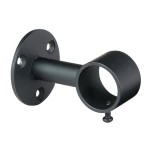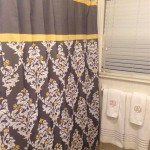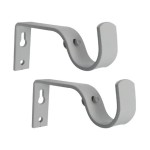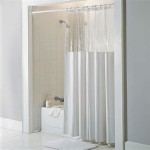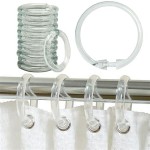Curtains to Keep Cold Out: An In-Depth Guide
The effectiveness of curtains in insulating a home against cold weather is a frequently discussed topic. While not a complete replacement for proper insulation, curtains can significantly contribute to reducing heat loss through windows, thereby improving energy efficiency and lowering heating costs. The key lies in understanding the different types of curtains available, their insulative properties, and how to properly install and utilize them.
Windows are often the weakest point in a building's thermal envelope. Single-pane windows, in particular, offer minimal resistance to heat transfer. Even double-pane windows, though superior, can still lose heat, especially if the seals are compromised or the glass is not treated with a low-emissivity (low-E) coating. This heat loss occurs through conduction, convection, and radiation. Cold air outside cools the windowpane, which in turn cools the air immediately adjacent to it. This cooled air then circulates throughout the room via convection, drawing heat away from the interior. Additionally, heat radiates directly through the glass.
Curtains act as a barrier against these heat transfer mechanisms. By layering fabric between the window and the room, curtains impede the flow of air and reduce the amount of heat radiating outwards. The effectiveness of this barrier depends on several factors, including the type of fabric, the thickness of the curtain, and the way the curtains are installed.
Understanding the Key Factors Influencing Curtain Insulation
Several factors determine how effectively curtains insulate against cold. These factors include the fabric type, the thickness and weight of the material, the presence of linings, and the installation method.
The type of fabric plays a significant role. Densely woven fabrics with a tight weave are generally more effective insulators. Natural fibers like wool and cotton, particularly when thick and heavy, offer good insulation. Synthetic fabrics, such as polyester and acrylic, can also provide effective insulation, especially when combined with a special backing or lining. The tightness of the weave prevents air from easily passing through the fabric, creating a barrier against convective heat loss.
Thickness and weight are directly related to insulation. A thicker, heavier curtain provides a greater barrier to heat transfer. The increased mass of the material slows down the conduction of heat through the curtain and reduces the amount of radiant heat that can pass through. Consider fabrics like velvet, fleece, or even multiple layers of lighter fabrics for enhanced insulation. These materials provide a substantial barrier against the cold.
Linings are an important addition to consider when evaluating curtain insulation. Blackout linings, designed to block light, also provide excellent insulation. These linings often consist of multiple layers of fabric, including a layer of dense, tightly woven material and a layer of thermal insulation. Thermal linings are specifically designed to reflect heat back into the room, further enhancing insulation. Adding a lining to existing curtains is a cost-effective way to improve their insulative properties without replacing the entire window treatment.
Proper installation is critical for maximizing the insulating benefits of curtains. Gaps around the edges of the curtains can negate much of their effectiveness. Curtains should be wide enough to extend beyond the window frame on all sides, creating a seal that prevents air from flowing around the edges. Installing curtains close to the window also helps to reduce air circulation between the window and the curtain. Using a curtain rod that wraps around the sides of the window can further minimize gaps. Consideration should be given for ensuring the curtains drape to the floor or extend to the window sill to help prevent air flow from the floor level upwards.
Types of Curtains and Their Insulating Properties
Various types of curtains offer different degrees of insulation. Understanding the characteristics of each type allows for selecting the best option based on specific needs and budget.
Thermal curtains are specifically designed for insulation. These curtains often consist of multiple layers of fabric, including a layer of insulating foam or batting. Thermal curtains are highly effective at blocking drafts and reducing heat loss. They are typically heavier and more expensive than standard curtains, but their energy-saving benefits can outweigh the initial cost. These curtains are designed with performance in mind allowing for maximization insulation.
Blackout curtains, while primarily intended to block light, also provide significant insulation. The dense, tightly woven fabric used in blackout curtains effectively prevents air from passing through, reducing both convective and radiant heat loss. Blackout curtains are a good option for bedrooms or other rooms where light control is also desired. They typically use multiple layers of material to achieve their level of light blocking and insulation.
Insulated window quilts are another option for window insulation. These quilts consist of multiple layers of fabric and batting sewn together to create a thick, insulated barrier. Window quilts are particularly effective at preventing drafts and reducing heat loss through windows. They are often custom-made to fit specific window sizes and shapes. This approach allows for a tailored fit to achieve maximum performance.
Heavy drapes, made from thick, dense fabrics like velvet or wool, can also provide good insulation. The weight and thickness of these fabrics create a barrier to heat transfer. While not specifically designed for insulation, heavy drapes can be an attractive and effective way to reduce heat loss through windows. The aesthetic appeal of these curtains coupled with their insulative properties make them a popular choice.
Cellular shades, while technically not curtains, provide excellent insulation. These shades consist of multiple layers of honeycomb-shaped cells that trap air, creating an insulating barrier. Cellular shades are available in a variety of materials and colors and can be customized to fit specific window sizes. While they operate differently than curtains, they fulfill a similar role in improving thermal performance.
Installation Techniques for Maximum Insulation
The way curtains are installed significantly impacts their ability to insulate a room. Proper installation minimizes drafts and maximizes the barrier against heat transfer.
The first step is to ensure that the curtains are wide enough to fully cover the window and extend beyond the frame on all sides. This overlap prevents drafts from entering around the edges of the curtains. A general rule of thumb is to add at least 4 to 8 inches of width to each side of the window frame. This ensures ample coverage and minimizes gaps. The top of the curtains should be placed high enough above the window to cover any exposed window frame.
Using a wraparound curtain rod is another effective technique for minimizing drafts. These rods curve around the sides of the window, preventing air from entering from the sides. Wraparound rods create a tighter seal around the window, further enhancing insulation. This design element is particularly useful in areas prone to strong winds or drafts.
Installing curtains close to the window also helps to reduce air circulation between the window and the curtain. This minimizes the amount of heat that can be lost through convection. Consider using a rod that is mounted close to the window frame or using tiebacks to keep the curtains close to the window. This approach reduces the air gap that could facilitate heat transfer.
For added insulation, consider using a valance or cornice at the top of the window. These decorative elements can help to block drafts from entering at the top of the curtains. A valance or cornice acts as a barrier, preventing cold air from seeping in from above. This is particularly effective in older homes with drafty windows.
During the winter months, keep curtains closed as much as possible, especially at night. This helps to trap heat inside the room. During the day, open curtains on south-facing windows to allow sunlight to enter and warm the room. However, be sure to close the curtains again before sunset to prevent heat from escaping. This strategic use of curtains can significantly improve energy efficiency.
Consider using thermal tape to seal the gaps around the edges of the window frame. This tape helps to prevent drafts from entering the room. Thermal tape is an inexpensive and easy-to-install solution for improving window insulation. It creates a tight seal, preventing air leakage and enhancing the effectiveness of the curtains.
Regularly inspect curtains for any tears or damage. Damaged curtains will not be as effective at insulating the room. Repair any tears or replace damaged curtains as needed. Maintaining the integrity of the curtains ensures that they continue to provide optimal insulation.
By understanding the factors that influence curtain insulation and implementing proper installation techniques, homeowners can significantly reduce heat loss through windows, improving energy efficiency and creating a more comfortable living environment during the colder months.

Wellco 31 5 In X 79 Gray Visible Plastic Thermal Insulated Door Curtain Magnetic Screen Noise Reduction Waterproof Csdsotvg80200

Insulated Door Curtain Magnetic Thermal 35 4x82 6 Inch Cover For Winter Doorways Keep Cold Heat Out Stop Wind Self Closing Air

Insulated Door Curtain Magnetic Thermal 35 4x82 6 Inch Cover For Winter Doorways Keep Cold Heat Out Stop Wind Self Closing Air

Insulated Curtains Stop Drafts Keep Out Cold Heat Reduce Heating And Electric Costs Energy Efficient Machine Washable Premium Tab Top

For 32 80 Inch Doors Magnetic Thermal Insulated Door Curtain Keep Cold Heat Out

Fits Door Size 32 80 Keep Cold Heat Out Center Opening Doorway Curtain

Curtain That Keep Out Cold

6 Best Window Coverings To Keep Cold Out

For 32 80 Inch Doors Magnetic Thermal Insulated Door Curtain Keep Cold Heat Out

Cozy Up Best Curtains To Keep The Cold Out This Winter

